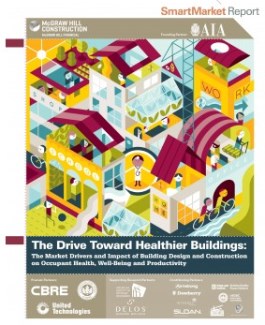
by Brianna Crandall — August 1, 2014—The need for greater public awareness and education about the impact of building design on health and well-being is confirmed by a new benchmark attitudinal study that explores and contrasts the attitudes of nonresidential and residential building owners and architects and designers, as well as human resources (HR) executives and physicians. A key finding was that the critical connection between a healthy building environment and patient health is often missed by the one group of professionals who may matter most—physicians.
“The Drive Toward Healthier Buildings: The Market Drivers and Impact of Building Design and Construction on Occupant Health, Well-Being and Productivity,” the latest SmartMarket Report by McGraw Hill Construction, finds that although 18% of homeowners say that doctors are their primary source for information on healthy home products and decisions, only 53% of pediatricians, 32% of family doctors/general practitioners and 40% of psychiatrists believe that buildings even impact patient health. The study suggests that getting more information to this group is essential to help create demand for more healthy building design and construction.
The researchers also found that nearly two-thirds of homeowners (63%) believe the products and practices they use in their homes affect their health. Yet for more homeowners, energy savings (79%) and aesthetics (65%) come before the effect of buildings on their health (59%) when they make design and construction decisions.
In fact, architects and designers (63%) currently consider the impact of buildings on occupants’ health more important to incorporate into their design than do building owners (59%). Over the next two years, health is expected to become more consequential in each group’s decisions. However, research predicts many more architects and designers (79%) than owners (67%) will base decisions on health concerns.
“There is a fundamental connection between our health and the design of places where we live, work, play and heal,” said Randy Fiser, executive vice president and CEO of the American Society of Interior Designers (ASID). “This research, which ASID helped to fund, indicates that designers and architects can encourage the adoption of healthy design practices and products by making the benefits clear and measurable to building owners.”
ASID and McGraw Hill Construction created an “Interior Design Data Excerpt” from the full report to highlight information of greatest interest to the design community among the comprehensive research findings.
According to the study, home and facilities owners need more comprehensive data to support investments in healthier building practices and products. So, unsurprisingly, credible information is the third most critical factor for design and building professionals emphasizing design’s effects on health impacts, as reported by 38% of those surveyed in both the residential and nonresidential building sectors.
In the nonresidential sector, greater public awareness, at 43%, and greater owner demand, at 45%, rank second and first, respectively. Similarly owner demand, at 63%, tops the list of factors prompting residential designers and architects to stress the need for healthier buildings. The second greatest factor is stricter regulations.
“The research in this report shows that interior designers and architects are leading other players in the focus they are putting on health in their work planned over the next few years,” says Harvey Bernstein, vice president of Industry Insights & Alliances at McGraw Hill Construction. “However, they need these drivers to help their designs come to fruition.”
Residential designers most often turn to material provided by product manufacturers for data about the connection between health and homes. Those same designers use data provided by associations at the second highest rate, with 75% using it at least sometimes and 30% using it often.
By contrast, architects and designers, 79%, cite television as the top source from which the general public learns about healthy design. They list consumer magazines next at 66% and product labels and Web sites third at 30%.
Each source possesses its own challenges in reaching the general public. To overcome those deficits, ASID Research will expand knowledge about the impact of design on health and wellness while the Society disseminates the information through its continuing education, Web site and conferences. Over the next few months, ASID Research will issue data on the Affordable Care Act and initiatives pursued through ASID Transform grants.
“The Drive Toward Healthier Buildings” was produced by McGraw Hill Construction in partnership with the American Institute of Architects and other research partners, including ASID. The report is the first research project to unite the five key stakeholders—physicians, construction industry professionals in both residential and nonresidential sectors, human resources (HR) executives, and homeowners—who influence the prevalence of healthy design and construction practices in buildings.




